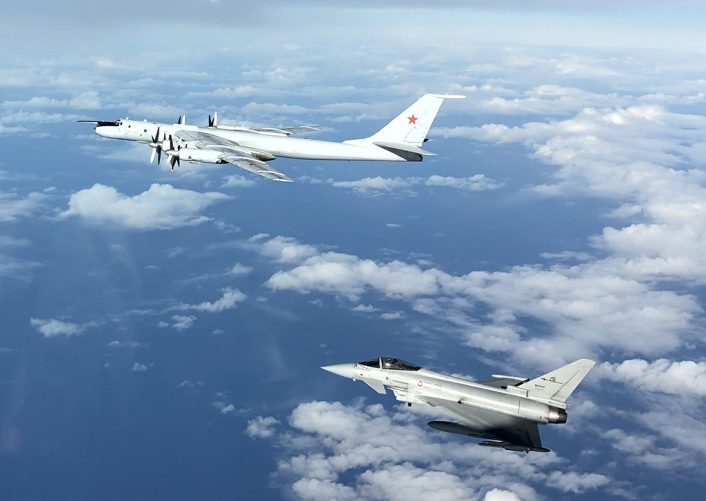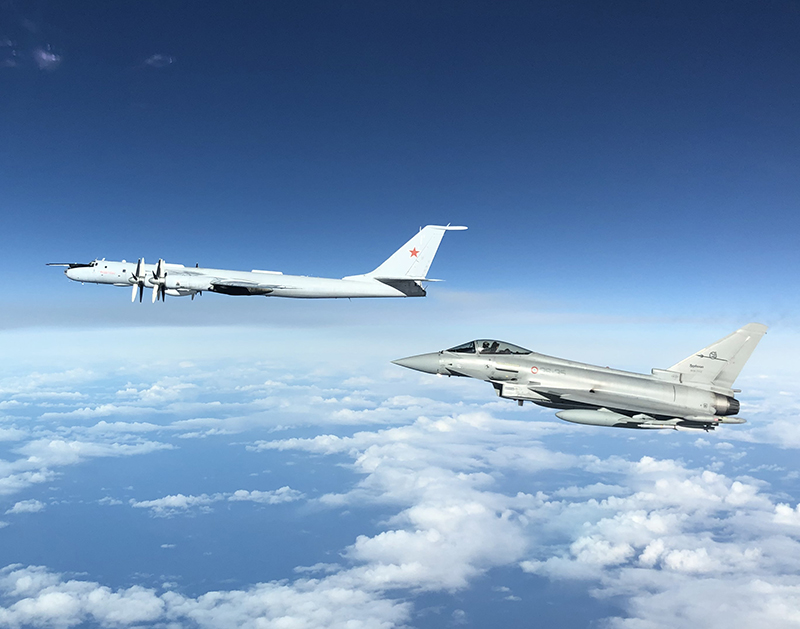We have obtained two photographs of the intercept the Italian Eurofighter Typhoons carried out on two Russian Navy Tu-142 Bear-F long-range maritime patrol reconnaissance and anti-submarine warfare aircraft last week.
As already reported, on Mar. 18, 2019, two Italian Air Force Eurofighter Typhoon jets deployed to Keflavik, Iceland, to support NATO’s Air Policing operations, were scrambled to intercept and escort two Russian Tu-142 Bear F aircraft flying in the vicinity of the Icelandic borders.
The intercept was the first carried out since the F-2000A jets (as the Italian Typhoons are designated in accordance with Italy’s MoD Mission Design Series) arrived in Iceland for a 4-week deployment on Mar. 11, 2019: the Typhoons, at the fourth rotation in support of NATO’s Icelandic Air Policing (the previous ones were in 2013, 2017 and 2018), undertake QRA (Quick Reaction Alert) duties, providing intercept capabilities for Iceland, a NATO ally that does not have a full range of air defence assets; a task periodically carried out also by fighter aircraft from Canada, the Czech Republic, Denmark, France, Germany, Norway, Portugal and the United States.
With the help of NATO Allied Air Command, we have obtained two images (courtesy of the Italian Air Force) taken by the Italian pilots as they shadowed the pretty rare aircraft: these allow the identification of at least one of the two maritime patrol and ASW (Anti-Submarine Warfare) as a Tu-142MK (NATO reporting name Bear-F Mod. 3).
Considered that Russia’s Naval Aviation operates just one squadron of Tu-142MKs, it’s safe to assume the aircraft belonged to the 2nd Guards Aviation Group with the 403rd Independent Composite Aviation Regiment, based at Kipelovo-Fedotovo in the western part of Russia (northeast of Moscow).

The Tu-142MK is designed to perform ASW: in other words, its goal is to search and destroy submarines in distant patrol areas. The aircraft can carry out maritime reconnaissance, aiming, and search-and-rescue operations too. Based on the Tu-95RT, a maritime reconnaissance variant of the baseline strategic bomber produced for naval operations, it has a maximum speed of 855 km/h, cruising speed of 720 km/h and a range of 12,550 km.
The Tu-142MK and the latest MZ variant (the Bear-F Mod. 4, with new NK-12MP engines and a new avionics suite, easily distinguishable because of the chin fairings) are both able to carry a maximum of 9,000 kg (19,842lb) weapons load inside two fuselage weapons bays, with options including three torpedoes (the rocket-propelled APR-2/APR-3, or the electric AT-2M or UMGT-1) or depth charges (such as the Zagon/Zagon-2 guided charges and nuclear depth charges), mines and sonobuoys. The typical loadout of a Tu-142MK comprises 3x torpedoes and 66x RGB-75, 44x RGB-15, 10x RGB-25 and 15 RGB-55 sonobuoys.
The last time two Tu-142s were intercepted by NATO aircraft was on Sept. 1, 2018, when four JASDF (Japan Air Self Defense Force) jets were scrambled to shadow two Tu-142MZs that were circumnavigating the major islands of the Japanese archipelago.









